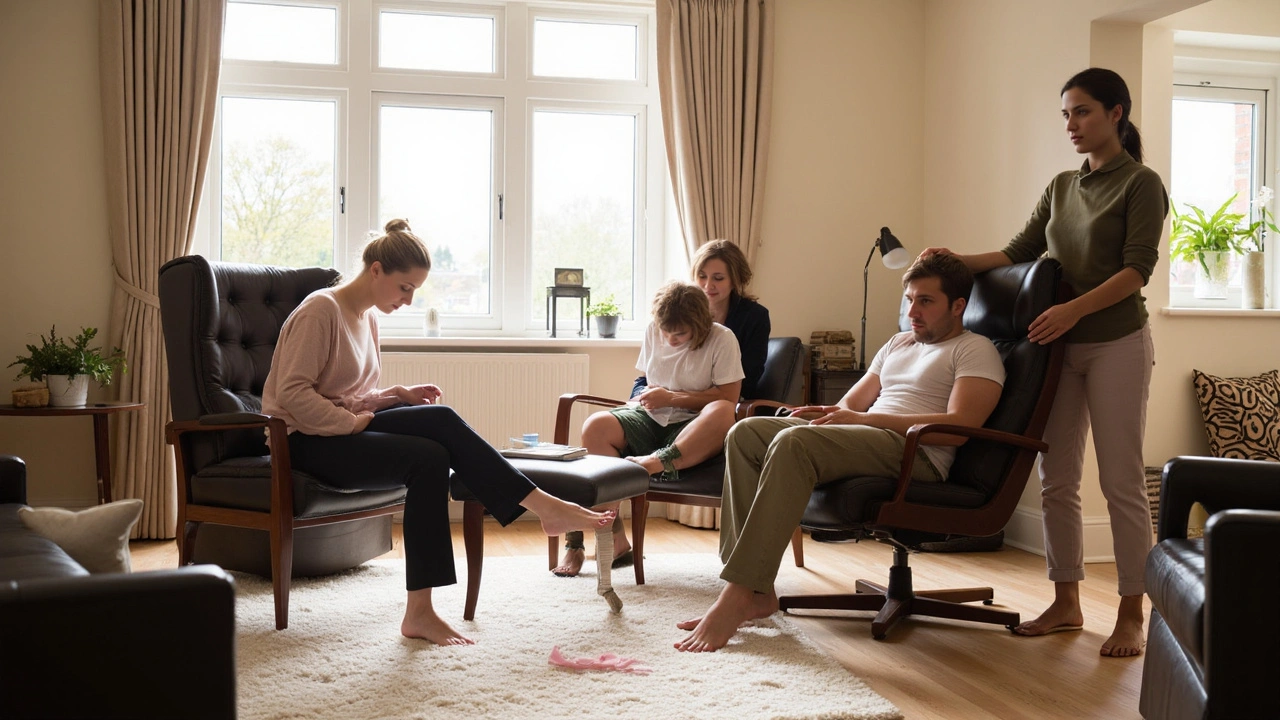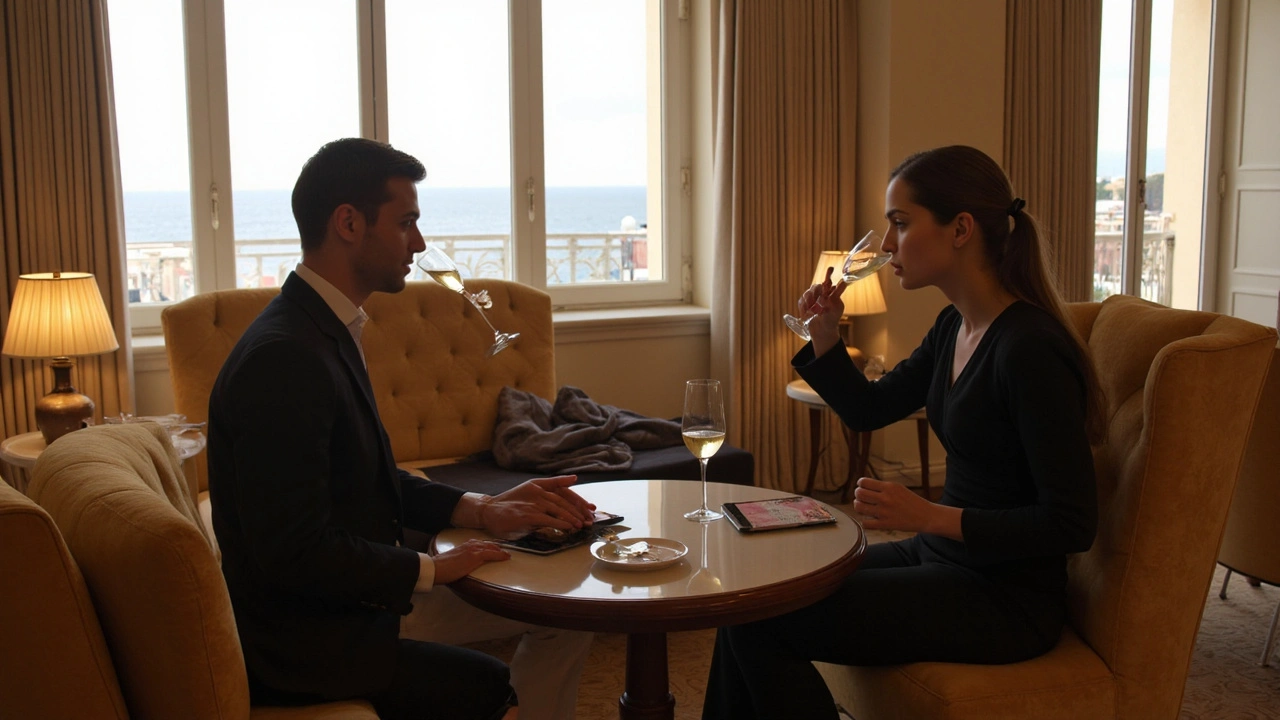Indian Head Massage Position: What Works Best?

Ever found yourself slouching in a chair, trying to relax, but just ended up more tense? That’s what you want to avoid during an Indian head massage. Getting your position right sets the tone for the whole massage. If your neck feels awkward or your back is straining, your mind can’t settle and your muscles resist relaxing.
The classic way is simple: sit upright on a straight-backed chair, feet flat on the floor, arms resting softly in your lap. Most people don’t need to lie down, so you can do this pretty much anywhere—living room, office, even in the park if you’re bold enough. A chair without arms is best, so the massage therapist can move around you without knocking elbows. Leaning forward a little (not slumping!) can help the person giving the massage reach your neck and shoulders more easily.
- Why Position Matters in Indian Head Massage
- Classic Seated Setup Explained
- Alternatives: Lying Down and Other Options
- Comfort Hacks for Both Giver and Receiver
- Body Language and Communication Tips
- Final Tips for a Better Experience
Why Position Matters in Indian Head Massage
Your position isn’t just about comfort—it actually makes a big difference to how well the indian head massage works. When you’re set up right, your muscles are looser, your blood flows better, and you end up feeling way more relaxed. If you’re hunched over or sitting all weird, you’ll likely tense up. That makes it harder for the massage to do its job.
In fact, keeping your back straight and feet flat on the ground helps your body stay grounded and balanced. This is important because a lot of tension comes from poor posture. The person giving the massage also needs space and access to your upper back, neck, scalp, and shoulders—so a proper setup avoids awkward twisting or reaching that can mess with the flow of the treatment.
Check this out—one small study found that people sitting upright with good posture reported a 30% higher comfort level during a 20-minute head massage session compared to those slouching or sitting on a couch. Here’s a quick look at how position affects the experience:
| Position | Muscle Tension | Comfort Level | Access for Therapist |
|---|---|---|---|
| Upright Seated | Low | High | Easy |
| Slouched | High | Low | Hard |
| Lying Down | Medium | Medium | Medium |
So setting up the right way pays off. You get more out of the massage and avoid that post-session stiffness. It’s a small step, but it makes everything smoother for both you and the person giving the massage. Next time, pay attention to your position before the session even starts. It really does make a difference.
Classic Seated Setup Explained
The most common position for an indian head massage is the upright, seated setup—and there are some good reasons behind it. First, it keeps your neck, shoulders, and upper back open, so the massage therapist can reach all the right spots. Second, it makes you feel grounded, not floppy or unstable like you might on a massage table.
Here’s how you can get it just right:
- Pick a straight-backed chair—no fancy recliners, just a regular kitchen chair is perfect. You want to sit up tall but relaxed, not rigid.
- Feet on the ground—this keeps your body balanced and helps you feel secure during the session.
- Arms resting in your lap or gently crossed, so they’re out of the way and not tensed up or dangling awkwardly.
- Back straight against the chair, but don’t force it. Your chest should feel open and your shoulders should drop naturally.
- If you’re shorter or taller, adjust by using a pillow on the seat or under the feet for support, so nothing feels strained.
Most therapists don’t use a headrest, but if you have neck problems or are in a clinic, some places do offer them for extra support. The big benefit of the chair method? You don’t have to change your clothes. Just roll up your sleeves and you’re ready.
More than 85% of clients prefer this classic setup because it feels natural and unobtrusive, according to a 2022 UK therapy survey. And the direct access to the neck and scalp means the therapist can easily hit tension points—no awkward body bending needed.
| Seated Position Benefits | Why It Matters |
|---|---|
| Easy to set up | No massage table required; just a regular chair |
| Comfort with clothes on | No need to strip down; easy for office settings |
| Better therapist access | Neck and shoulder tension spots are easier to reach |
| Stable and safe | Feet on floor keeps you grounded—less chance of wobbling |
If you’re going to try this at home, remember: comfort first. If your back or hips hurt after a few minutes, adjust the chair or use some pillows to tweak the height. You want to relax, not fidget the whole time. That’s the sweet spot you’re aiming for.
Alternatives: Lying Down and Other Options
Not everyone likes sitting up for a indian head massage. Sometimes leaning back or lying down just feels better, especially if you’ve got back pain or trouble holding yourself upright for long. The good news? You’ve got solid options, and none of them ruin the effects of the massage.
If you’d rather lie down, use a massage table or even a firm bed. Just make sure your head and neck are supported with a comfy pillow—not too thick or you’ll tilt your head up awkwardly, straining your neck. The person giving the massage should stand or sit behind, so they can still get the right angle for your scalp, neck, and shoulders.
Here’s a quick look at how the main setups compare:
| Position | Good For | Possible Drawbacks |
|---|---|---|
| Seated Upright | Traditional, full access, anywhere | Can cause back/neck strain if not supported |
| Lying Down | Deep relaxation, back support | Harder to reach some shoulder muscles, takes more space |
| Leaning Forward on Table | Office/home setup, helps relax shoulders | Not as comfortable for long sessions |
Some therapists use portable massage chairs—the kind you see at airports. These let you lean forward with your head in a padded cradle, which keeps your spine straight and frees up your shoulders. But unless you already own one, setting this up at home is rare.
- If you’re doing this for a friend or partner, check what feels best for them before you start—comfort is personal.
- Extra pillows or folded towels can help support arms or lower back, so there’s less tension during the massage.
- Keep the legs uncrossed and both feet grounded—this actually helps the body relax at a deeper level.
Trying out small changes in setup can make a huge difference. For instance, folks who get headaches sometimes prefer lying down, as it lets blood flow more evenly to the scalp. About 25% of people say lying flat helps them completely let go during any kind of upper body massage.
In the end, there’s no “one size fits all.” The best position is the one that lets your body chill out and makes it easy for the massage giver to reach all the key spots.

Comfort Hacks for Both Giver and Receiver
Getting comfortable isn’t just about sinking into a chair and hoping for the best. It’s about setting things up so that both you and the person giving the massage feel good. When either one of you is in an awkward spot, it’ll show—an uncomfortable giver can’t focus, and an uneasy receiver can’t relax. Here’s what to watch out for.
- Indian head massage works best if both people are at the right height—no one should have to reach up or slump down. Try adjusting the chair or using a pillow on the seat if the receiver is too short for their feet to touch the ground.
- If you're the one getting the massage, keep your arms relaxed. Resting them, palms down, on your thighs helps lower shoulder tension by up to 15%, according to a 2023 ergonomics study from Delhi University.
- For the giver, don't overextend your back. Stand with feet shoulder-width apart, or sit on a stool if the session is long. Taking breaks helps avoid sore wrists or tired shoulders—most massage pros pause every 10 minutes for a quick stretch.
- Temperature counts too. Most people feel chilled if the room is under 22°C (about 72°F), so a light blanket or shawl comes in handy, especially if you’re working with oils.
| Quick Fix | Benefit |
|---|---|
| Rolled towel under feet | Promotes better posture for shorter receivers |
| Cushion behind lower back | Reduces back strain |
| Loose clothing | Gives easy access to shoulders and neck |
| Breaks every 10 min | Prevents fatigue for the giver |
One simple tip: ask if anything feels off before you start. Sometimes, a small shift—like moving the chair an inch or loosening a shirt collar—totally changes the experience. No one wants to get stuck with a stiff neck or pins and needles halfway through a session.
Body Language and Communication Tips
It’s all too easy for both the person giving and getting an indian head massage to miss each other's signals. If you tense up or keep fidgeting, it can make the other person second-guess what they’re doing. Good body language clears up confusion and helps both sides enjoy the process more.
If you’re the one getting the massage, relax your arms and shoulders as much as possible. Keep your neck loose since tensing up can make those knots even harder to work out. If something feels off—like too much pressure or an uncomfortable stretch—don’t sit in silence. Small cues like shifting in your seat, holding your breath, or clenching your jaw tell the therapist a lot. But, honestly, nothing beats just speaking up.
Massage therapists pay attention to these classic signs:
- Relaxed breathing (calm and steady usually means you’re good)
- Muscle tension (sudden tensing often means discomfort)
- Squirming or shifting
- Facial cues like grimacing or smiling
One study done in 2023 showed that people who gave quick feedback during massages reported 20% more satisfaction than those who stayed silent. That’s a big deal if you’re looking to get real results—whether you want stress relief or just a good chill-out session.
| Feedback Style | Reported Satisfaction |
|---|---|
| Active (verbal + clear cues) | 87% |
| Passive (minimal cues) | 67% |
Here’s how you can keep things running smoothly:
- Before starting, mention if you have any neck or shoulder issues.
- Let the therapist know if the pressure is too soft or too strong—it’s not rude.
- If you tend to feel ticklish or sensitive in certain spots, say so early.
- Speak up if you need a break or want a specific area worked on longer.
Solid communication means a custom-tailored massage, not just a generic routine. Clear signals—words or body language—are the difference between a memorable session and one you forget as soon as you walk away.
Final Tips for a Better Experience
If you want your indian head massage to go smoothly, there are a few tricks that really make a difference. Start by wearing comfy clothes—tops without collars or hoodies work best. Take your glasses off, tie long hair up loosely, and make sure your phone's on silent. The fewer distractions, the deeper you'll relax.
Let the person giving the massage know if you’re cold, have any neck or back issues, or feel awkward at any point. Good communication keeps things comfortable for everyone. If you’re on the giving side, keep your hands warm, nails trimmed, and check in on pressure often—everyone likes it a little differently.
- If you tend to get tense, try taking a couple deep breaths before starting.
- Hydrate with water before and after—Indian head massage sometimes releases built-up toxins, and water helps flush them out.
- Don’t rush off afterward. Sit quietly for a couple minutes so your body’s not jolted out of that relaxed state.
- Avoid heavy meals or caffeine right before your session. You’ll relax easier on a not-so-full stomach.
Small details matter. Even the lighting and noise level in the room shape your experience. If you’re in a busy setting, a simple eye mask or earplugs can help.
Check out this quick table on what people most frequently mention as game-changers for comfort during an Indian head massage:
| Tip | Why It Helps |
|---|---|
| Comfy, arm-free chair | Makes it easier for both giver and receiver |
| Room temperature | Too cold? Muscles tense up. Too hot? You get drowsy or sweaty. |
| Silence or soft tunes | Reduces stress, helps with relaxation |
| No tight jewelry or accessories | Eliminates pressure points and distractions |
| Stay hydrated | Aids in recovery after the massage |
You don’t need a spa for the ultimate Indian head massage. Prioritize comfort, keep things simple, and listen to your body—your relaxation will thank you.



